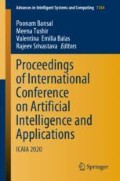Abstract
Information diffusion is employed to track the spread of information in the online social network, and hence, is considered extremely relevant to several modern-day applications. It is of pivotal importance for addressing challenges associated with the influence maximization in social media. Our research focuses on the diffusion process to track the temporal extent of information spread in the network. Over time, various models have been suggested in order to best represent the diffusion process. Our paper suggests a novel information diffusion model, time-aware opinion dynamics model (TODD), that derives from opinion dynamics and continuous time models in order to provide a more robust and realistic representation of the real-world problem. A comparative study is conducted between our proposed model and several existing methods.
Access this chapter
Tax calculation will be finalised at checkout
Purchases are for personal use only
References
O. Tsur, A. Rappoport, What’s in a hashtag? in Proceedings of the Fifth ACM International Conference on Web Search and Data Mining—WSDM ’12 (2012)
Influence maximization on social graphs: a survey. IEEE Trans. Knowl. Data Eng. (2018)
S.P. Borgatti, Centrality and network flow. Soc. Netw. 27(1), 55–71 (2005)
L.C. Freeman, Centrality in social networks conceptual clarification. Soc. Netw. 1(3), 215–239 (1978)
Tore Opsahl, Filip Agneessens, John Skvoretz, Node centrality in weighted networks: generalizing degree and shortest paths. Soc. Netw. 32(3), 245–251 (2010)
J. Leskovec, D. Huttenlocher, J. Kleinberg, Signed networks in social media, in Proceedings of the 28th International Conference on Human Factors in Computing Systems—CHI ’10 (2010)
A. Hassan, A. Abu-Jbara, D. Radev, Extracting signed social networks from text, in Workshop Proceedings of TextGraphs-7 on Graph-based Methods for Natural Language Processing, TextGraphs-7 ’12 (Association for Computational Linguistics, Stroudsburg, PA, USA, 2012), pp. 6–14
J. Kunegis, A. Lommatzsch, C. Bauckhage, The slashdot zoo, in Proceedings of the 18th international Conference on World Wide Web—WWW ’09 (2009)
Fritz Heider, Attitudes and cognitive organization. J. Psychol. 21(1), 107–112 (1946)
R. Guha, R. Kumar, P. Raghavan, A. Tomkins, Propagation of trust and distrust, in Proceedings of the 13th Conference on World Wide Web—WWW ’04 (2004)
D. Kempe, J. Kleinberg, É. Tardos, Maximizing the spread of influence through a social network, in Proceedings of the Ninth ACM SIGKDD International Conference on Knowledge Discovery and Data Mining—KDD ’03 (2003)
J. Leskovec, A. Krause, C. Guestrin, C. Faloutsos, C. Faloutsos, J. VanBriesen, N. Glance, Cost-effective outbreak detection in networks, in Proceedings of the 13th ACM SIGKDD International Conference on Knowledge Discovery and Data Mining, KDD ’07 (ACM, New York, NY, USA, 2007), pp. 420–429
A. Goyal, W. Lu, L.V.S. Lakshmanan, Celf++: optimizing the greedy algorithm for influence maximization in social networks, in WWW (2011)
M. Cha, H. Haddadi, F. Benevenuto, K. Gummadi, Measuring user influence in twitter: the million follower fallacy (2010)
M. Granovetter, Threshold models of collective behavior. Am. J. Sociol. 83(6), 1420–1443 (1978)
M. Gomez-Rodriguez, D. Balduzzi, B. Scholkopf, Uncovering the temporal dynamics of diffusion networks (2011). CoRR, abs/1105.0697
Opinion dynamics with disagreement and modulated information. J. Stat. Phys. (2013)
A model for spatial conflict. Biometrika (1973)
Minority opinion spreading in random geometry. Eur. Phys. J. B Condens. Matter Complex Syst. (1973)
Reducing individuals’ risk sensitiveness can promote positive and non-alarmist views about catastrophic events in an agent-based simulation
Opinion evolution in closed community. Int. J. Mod. Phys. C
Author information
Authors and Affiliations
Corresponding author
Editor information
Editors and Affiliations
Rights and permissions
Copyright information
© 2021 The Editor(s) (if applicable) and The Author(s), under exclusive license to Springer Nature Singapore Pte Ltd.
About this paper
Cite this paper
Lahiri, A., Singhal, Y.K., Sinha, A. (2021). TODD: Time-Aware Opinion Dynamics Diffusion Model for Online Social Networks. In: Bansal, P., Tushir, M., Balas, V., Srivastava, R. (eds) Proceedings of International Conference on Artificial Intelligence and Applications. Advances in Intelligent Systems and Computing, vol 1164. Springer, Singapore. https://doi.org/10.1007/978-981-15-4992-2_23
Download citation
DOI: https://doi.org/10.1007/978-981-15-4992-2_23
Published:
Publisher Name: Springer, Singapore
Print ISBN: 978-981-15-4991-5
Online ISBN: 978-981-15-4992-2
eBook Packages: Intelligent Technologies and RoboticsIntelligent Technologies and Robotics (R0)

